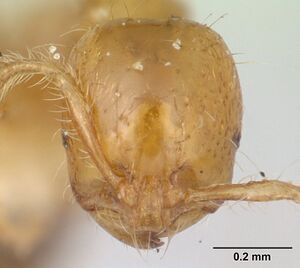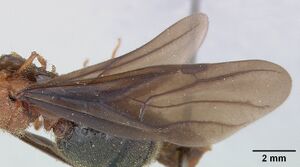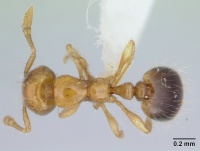Solenopsis bicolor
| Solenopsis bicolor | |
|---|---|

| |
| Scientific classification | |
| Kingdom: | Animalia |
| Phylum: | Arthropoda |
| Class: | Insecta |
| Order: | Hymenoptera |
| Family: | Formicidae |
| Subfamily: | Myrmicinae |
| Tribe: | Solenopsidini |
| Genus: | Solenopsis |
| Species complex: | wasmannii |
| Species: | S. bicolor |
| Binomial name | |
| Solenopsis bicolor (Emery, 1906) | |
| Synonyms | |
| |
This species was collected among a nest of Atta cephalotes in Sierra Nevada de Santa Maria, Colombia (Forel 1912). Eidmann (1936) states that Forel (1912) found colonies in the nests of Nasutitermes (Diversitermes) sp. and Acromyrmex subterraneus from (Ettershank 1966). Mark Deyrup collected specimens in the Bahamas in a garden in a pile of old coconuts (pers. comm.). Solenopsis bicolor was also found nesting in the wall of a residence in Colombia. It has been collected with surface bait in rain forest and in forest leaf litter in Venezuela, foraging on a road in Belize, at 200 m in Peru and in Berlese leaf litter old growth dry tropical forest in Costa Rica at 300 m. (Pacheco and Mackay 2013)
Identification
A New World thief ant that is a member of the wasmannii species complex.
Pacheco and Mackay (2013) – Worker - This is a bicolored species with a golden-yellow body and brown gaster. The defining character of this species is that the lateral and extralateral clypeal teeth are completely absent. The clypeal carinae extend from the anterior border of the clypeus posteriorly between the antennal insertions and turn medially back around to the anterior border of the clypeus, forming a relatively large socket. The petiole and postpetiole are robust. This species has long erect hairs, especially on the head and mesosoma. Workers are dimorphic, with the total length of the minor being about 1 mm, the major worker about 2 mm. The minor looks like a smaller version of the major.
Queen - Specimens are relatively small (Total Length 2.8-3.6 mm) bicolored (head and mesosoma red, gaster dark brown or black), with the clypeus in the same form as in the worker. The clypeal teeth are completely absent and the anterior border of the clypeus is defined by a raised flange. Specimens have long hairs as in the worker.
The workers of Solenopsis spei are identical in form and size to those of Carebarella bicolor. Both species are monomorphic and are thus recognized here as the same species. Carebarella bicolor is included in this monograph as it is apparently actually a species of Solenopsis.
The workers of C. bicolor are similar to those of Solenopsis altinodis which overlaps it in distribution, but can be differentiated from S. altinodis as this species has a conspicuously high, thick petiolar node (wider than high in profile). The minor workers of Solenopsis iheringi are nearly identical to those of S. bicolor and a subtle difference in the clypeal carinae distinguishes them if no major workers are collected in a series. The carinae reach the anterior border of the clypeus in S. bicolor, but do not touch the anterior border in minor workers of Solenopsis iheringi. Additionally, S. bicolor has longer setae on all body surfaces (especially on the head and mesosoma), as compared to S. iheringi (southern South America).
Keys including this Species
Distribution
Latitudinal Distribution Pattern
Latitudinal Range: 17.972222° to -27.37°.
| North Temperate |
North Subtropical |
Tropical | South Subtropical |
South Temperate |
- Source: AntMaps
Distribution based on Regional Taxon Lists
Neotropical Region: Argentina (type locality), Bahamas, Belize, Bolivia, Brazil, Colombia, Costa Rica, Honduras, Mexico, Panama, Peru, Venezuela.
Distribution based on AntMaps
Distribution based on AntWeb specimens
Check data from AntWeb
Countries Occupied
| Number of countries occupied by this species based on AntWiki Regional Taxon Lists. In general, fewer countries occupied indicates a narrower range, while more countries indicates a more widespread species. |

|
Estimated Abundance
| Relative abundance based on number of AntMaps records per species (this species within the purple bar). Fewer records (to the left) indicates a less abundant/encountered species while more records (to the right) indicates more abundant/encountered species. |

|
Biology
Castes
Workers are dimorphic, with the total length of the minor being about 1 mm, the major worker about 2 mm. The minor looks like a smaller version of the major.
Worker
Images from AntWeb
   
| |
| Worker. Specimen code casent0178485. Photographer April Nobile, uploaded by California Academy of Sciences. | Owned by MZSP, Sao Paulo, Brazil. |
   
| |
| Worker. Specimen code casent0178631. Photographer April Nobile, uploaded by California Academy of Sciences. | Owned by MIZA, Maracay, Venezuela. |
Queen
Images from AntWeb
    
| |
| Queen (alate/dealate). Specimen code casent0178484. Photographer April Nobile, uploaded by California Academy of Sciences. | Owned by MZSP, Sao Paulo, Brazil. |
Nomenclature
The following information is derived from Barry Bolton's Online Catalogue of the Ants of the World.
- bicolor. Carebarella bicolor Emery, 1906c: 138 (q.) ARGENTINA (Misiones).
- Type-material: holotype queen.
- Type-locality: Argentina: Misiones, Santa Ana (F. Silvestri).
- Type-depository: MSNG.
- Borgmeier, 1948b: 465 (w.m.).
- Combination in Solenopsis: Pacheco & Mackay, 2013: 37, 119.
- Status as species: Bruch, 1914: 222; Emery, 1922e: 194; Borgmeier, 1937b: 235; Borgmeier, 1948b: 465 (redescription); Kusnezov, 1953b: 337; Ettershank, 1966: 115; Kempf, 1969: 281; Kempf, 1972a: 74; Brandão, 1991: 336; Bolton, 1995b: 134; Wild, 2007b: 31; Pacheco & Mackay, 2013: 119 (redescription); Bezděčková, et al. 2015: 121; Fernández & Serna, 2019: 815.
- Senior synonym of punctatorugosa: Kempf, 1969: 281; Kempf, 1972a: 74; Bolton, 1995b: 134; Pacheco & Mackay, 2013: 119.
- Senior synonym of spei: Pacheco & Mackay, 2013: 119.
- Distribution: Argentina, Bahamas, Belize, Bolivia, Colombia, Costa Rica, Panama, Peru, Venezuela.
- punctatorugosa. Carebarella bicolor var. punctatorugosa Emery, 1906c: 139 (footnote), fig. 18 (q.) BRAZIL (Rio de Janeiro).
- Type-material: syntype queens (number not stated).
- Type-locality: Brazil: Rio de Janeiro (no collector’s name).
- Type-depository: MSNG.
- [Misspelled as punctorugosa by Borgmeier, 1927c: 102.]
- Eidmann, 1936a: 43 (w.l.).
- Subspecies of bicolor: Emery, 1922e: 194; Borgmeier, 1927c: 102; Eidmann, 1936a: 43; Borgmeier, 1937b: 235.
- Status as species: Ettershank, 1966: 115.
- Junior synonym of bicolor: Kempf, 1969: 281; Kempf, 1972a: 74; Bolton, 1995b: 134; Pacheco & Mackay, 2013: 119.
- spei. Solenopsis spei Forel, 1912g: 11 (w.) COLOMBIA.
- Type-material: lectotype worker (by designation of Pacheco & Mackay, 2013: 121), 5 paralectotype workers.
- Type-locality: lectotype Colombia: Sierra Nevada de Santa Marta, Dibulla, Hacienda de l’Esperanza (A.Forel); paralectotypes with same data.
- Type-depository: MHNG.
- Status as species: Emery, 1922e: 201; Ettershank, 1966: 143; Kempf, 1972a: 240; Bolton, 1995b: 391.
- Junior synonym of bicolor: Pacheco & Mackay, 2013: 119.
Unless otherwise noted the text for the remainder of this section is reported from the publication that includes the original description.
Description
Worker
Pacheco and Mackay (2013) – Major Measurements (n=6). TL 1.98-2.04 (2.03); HL 0.534-0.570 (0.549); HW 0.420-0.480 (0.451); EL 0.048; ED 0.036; SL 0.324-0.360 (0.344); FSL 0.126-0.138 (0.133); CI 78.7-84.2 (82.0); SI 56.2-63.2 (60.9); PL 0.096; PW 0.156-0.186 (0.169); PI 51.6-61.5 (57.0); PPL 0.15; PPW 0.180-0.186 (0.185); PPI 80.7-83.3 (81.2); WL 0.390-0.420 (0.403).
Minor Measurements (n=2). TL 1.14-1.20; HL 0.306-0.450; HW 0.300-0.390; EL 0.036-0.042; ED 0.030-0.036; SL 0.186-0.258; FSL 0.078-0.108; CI 87-98; SI 57-61; PSL 0.036-0.042, PSW 0.030-0.036, PL 0.084-0.090; PW 0.126-0.132; PI 67-68; PPL 0.096-0.102; PPW 0.120-0.138; PPI 74-80; WL 0.366-0.474.
Worker description (major and minor). Bicolored, golden-yellow body, brown gaster; lateral and extralateral teeth absent; clypeal carinae extend from anterior border of clypeus between antennal insertions, turn medially back around to anterior border of clypeus forming elongated socket; scape reaches ¾ length of head, not reaching posterior border; funicular segments 2-4 slightly swollen; head nearly quadrate with posterior border straight; eyes small, approximately 3 to 5 ommatidia; notopropodeal suture well depressed, groove breaks sculpture of mesosoma; punctures present on mesosoma; propodeum has angular posterior edge dorsally; mesopleuron, metapleuron with horizontal striae; petiole, postpetiole thick, with roughened sculpturing, with petiole slightly wider when viewed laterally.
Long erect hairs present throughout body surfaces; approximately 30 hairs present on scape; seven hairs on anterior border of clypeus; approximately 14 suberect hairs line posterior border of head; when viewed in profile, pronotum has eight erect hairs (nearly 0.240 mm in length); propodeum nearly absent of pilosity; three to four hairs on petiole and postpetiole; first tergite of gaster has seven long suberect hairs.
Queen
Pacheco and Mackay (2013) - Measurements (n=2). TL 2.75-3.66; HL 0.510-0.516; HW 0.498-0.546; EL 0.174-0.180; ED 0.150-0.156; SL 0.270-0.288; FSL 0.108-0.132; CI 98-106; SI 53-56; PSL 0.054-0.060, PSW 0.048-0.051, PL 0.150; PW 0.234-0.246; PI 112-164; PPL 0.168-0.180; PPW 0.282-0.288; PPI 157-172; WL 0.504-0.510.
Bicolored, head, mesosoma, petiole, and postpetiole red, gaster mostly dark brown to black; mandible with four teeth; anterior border of clypeus without teeth, although slightly angulate latterly; anterior border with small upturned flange; eyes extending well past sides of head, scape extending 2/3 length to posterior lateral comer of head; ocelli well developed; sides of head broadly rounded, posterior border nearly straight; most surfaces of head smooth and glossy; mesosoma robust with evidence of wings; propodeal spiracle nearly circular in shape; anterior face of petiole concave, apex broadly rounded, posterior face concave, subpeduncular process developed into flange; dorsum of postpetiole broadly rounded; sides of petiole and postpetiole mostly punctae; surface of gaster finely coriaceous, mostly glossy and shining.
Erect and suberect hairs covering nearly all surfaces, including mandibles, clypeus, dorsum of head, sides of head, posterior border, antennae, mesosoma, legs, petiole, postpetiole and gaster; appressed hairs sparse, few on dorsum of head and dorsum of gaster.
Type Material
Pacheco and Mackay (2013) - Colombia, Guajira, Dibulla, (lectotype worker and 5 paralectotype workers [here designated] Forel coll. Musee d'Histoire Naturelle Genève).
References
- Borgmeier, T. 1948b. Einige Ameisen aus Argentinien (Hym. Formicidae). Rev. Entomol. (Rio J.) 19: 459-471 (page 465, worker, male described)
- Cantone, S., Von Zuben, C.J. 2019. The hindwings of ants: A phylogenetic analysis. Psyche: A Journal of Entomology 2019, 1–11 (doi:10.1155/2019/7929717).
- Emery, C. 1906c [1905]. Studi sulle formiche della fauna neotropica. XXVI. Bull. Soc. Entomol. Ital. 37: 107-194 (page 138, queen described)
- Franco, W., Ladino, N., Delabie, J.H.C., Dejean, A., Orivel, J., Fichaux, M., Groc, S., Leponce, M., Feitosa, R.M. 2019. First checklist of the ants (Hymenoptera: Formicidae) of French Guiana. Zootaxa 4674, 509–543 (doi:10.11646/zootaxa.4674.5.2).
- Jones, T.H., Adams, R.M.M., Spande, T.F., Garraffo, H.M., Kaneko, T., Schultz, T.R. 2012. Histrionicotoxin alkaloids finally detected in an ant. Journal of Natural Products 75: 1930–1936 (doi:10.1021/np300485v).
- Kempf, W. W. 1969. Miscellaneous studies on Neotropical ants. V. (Hymenoptera, Formicidae). Stud. Entomol. 12: 273-296 (page 281, Senior synonym of punctatorugosa)
- Pacheco, J.A. & Mackay, W.P. 2013. The systematics and biology of the New World thief ants of the genus Solenopsis (Hymenoptera: Formicidae). Edwin Mellen Press, Lewiston, New York. 501 pp.
- Sharaf, M.R., Gotzek, D., Guénard, B., Fisher, B.L., Aldawood, A.S., Al Dhafer, H.M., Mohamed, A.A. 2020. Molecular phylogenetic analysis and morphological reassessments of thief ants identify a new potential case of biological invasions. Scientific Reports 10, 12040 (doi:10.1038/s41598-020-69029-4).
References based on Global Ant Biodiversity Informatics
- Borgmeier T. 1948. Einige Ameisen aus Argentinien (Hym. Formicidae). Revista de Entomologia (Rio de Janeiro) 19: 459-471.
- Brandao, C.R.F. 1991. Adendos ao catalogo abreviado das formigas da regiao neotropical (Hymenoptera: Formicidae). Rev. Bras. Entomol. 35: 319-412.
- Bruch C. 1914. Catálogo sistemático de los formícidos argentinos. Revista del Museo de La Plata 19: 211-234.
- Calixto J. M. 2013. Lista preliminar das especies de formigas (Hymenoptera: Formicidae) do estado do Parana, Brasil. Universidad Federal do Parana 34 pages.
- Cuezzo, F. 1998. Formicidae. Chapter 42 in Morrone J.J., and S. Coscaron (dirs) Biodiversidad de artropodos argentinos: una perspectiva biotaxonomica Ediciones Sur, La Plata. Pages 452-462.
- Dattilo W. et al. 2019. MEXICO ANTS: incidence and abundance along the Nearctic-Neotropical interface. Ecology https://doi.org/10.1002/ecy.2944
- Del Toro, I., M. Vázquez, W.P. Mackay, P. Rojas and R. Zapata-Mata. Hormigas (Hymenoptera: Formicidae) de Tabasco: explorando la diversidad de la mirmecofauna en las selvas tropicales de baja altitud. Dugesiana 16(1):1-14.
- Emery C. 1906. Studi sulle formiche della fauna neotropica. XXVI. Bullettino della Società Entomologica Italiana 37: 107-194.
- Fernández F., E. E. Palacio, W. P. Mackay, and E. S. MacKay. 1996. Introducción al estudio de las hormigas (Hymenoptera: Formicidae) de Colombia. Pp. 349-412 in: Andrade M. G., G. Amat García, and F. Fernández. (eds.) 1996. Insectos de Colombia. Estudios escogidos. Bogotá: Academia Colombiana de Ciencias Exactas, Físicas y Naturales, 541 pp
- Fernández, F. and S. Sendoya. 2004. Lista de las hormigas neotropicales. Biota Colombiana Volume 5, Number 1.
- Forel A. 1912. Formicides néotropiques. Part IV. 3me sous-famille Myrmicinae Lep. (suite). Mémoires de la Société Entomologique de Belgique. 20: 1-32.
- Franco W., N. Ladino, J. H. C. Delabie, A. Dejean, J. Orivel, M. Fichaux, S. Groc, M. Leponce, and R. M. Feitosa. 2019. First checklist of the ants (Hymenoptera: Formicidae) of French Guiana. Zootaxa 4674(5): 509-543.
- Gomez V. E. S., and G. Z. González. 2007. Catalogo de Las Hormigas Presentes en El Museo de Historia Natural de la Universidad del Cauca. Popayán : 1-58.
- Kempf W. W. 1969. Miscellaneous studies on Neotropical ants. V. (Hymenoptera, Formicidae). Studia Entomologica 12: 273-296.
- Kempf W. W. 1978. A preliminary zoogeographical analysis of a regional ant fauna in Latin America. 114. Studia Entomologica 20: 43-62.
- Kempf, W.W. 1972. Catalago abreviado das formigas da regiao Neotropical (Hym. Formicidae) Studia Entomologica 15(1-4).
- Kusnezov N. 1956. Claves para la identificación de las hormigas de la fauna argentina. Idia 104-105: 1-56.
- Longino J. T. 2013. Ants of Honduras. Consulted on 18 Jan 2013. https://sites.google.com/site/longinollama/reports/ants-of-honduras
- Longino J. T. L., and M. G. Branstetter. 2018. The truncated bell: an enigmatic but pervasive elevational diversity pattern in Middle American ants. Ecography 41: 1-12.
- Longino J. T., J. Coddington, and R. K. Colwell. 2002. The ant fauna of a tropical rain forest: estimating species richness three different ways. Ecology 83: 689-702.
- Longino J. T., and R. K. Colwell. 2011. Density compensation, species composition, and richness of ants on a neotropical elevational gradient. Ecosphere 2(3): 16pp.
- Longino J. et al. ADMAC project. Accessed on March 24th 2017 at https://sites.google.com/site/admacsite/
- Pacheco J. A., and W. P. Mackay. 2013. The systematics and biology of the New World thief ants of the genus Solenopsis (Hymenoptera: Formicidae). Lewiston, New York: Edwin Mellen Press, 501 pp.
- Vittar, F. 2008. Hormigas (Hymenoptera: Formicidae) de la Mesopotamia Argentina. INSUGEO Miscelania 17(2):447-466

